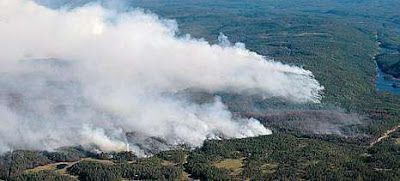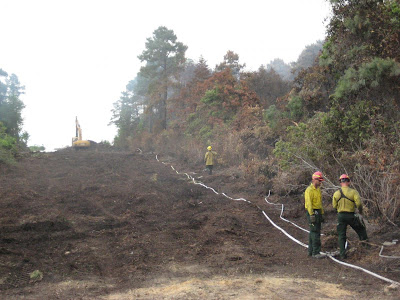Ellreese Daniels was the Crew Boss and Type 3 Incident Commander on the Thirtymile Fire near Winthrop, Washington in 2001 on which four members of his crew were overrun by fire and died. On January 30, 2007 the U.S. Attorney in Spokane, Washington charged him with eleven felony charges– four counts of involuntary manslaughter and seven counts of making false statements, which could have led to 56 years in prison.
On April 29 the U.S. Attorney reduced the eleven felony charges down to two misdemeanor charges of making false statements to investigators, to which Ellreese pled guilty.
Sentencing will occur August 18 and could result in probation or up to six months in jail.
Wildfire Today has posted about this case eight times.
Ellreese’s attorney, Tina Hunt, is requesting that:
“…if anyone would like to write a letter of support for Ellreese or to write a letter letting the court know how this case has affected them, I would be more than happy to collect those. I would rather they come directly to me so that I may make certain that the Court receives them.”
Her address is:
Christina Hunt
Federal Defenders of Eastern WA and ID
10 N. Post St., Ste. 700
Spokane, WA 99201
If you have been following this case on Wildfire Today, you know how I stand. I was not on the Thirtymile Fire, so all I know is what I read in the report and from talking with some people very close to the situation.
Ellreese may have made some mistakes on the fire… a fire that exhibited extreme fire behavior. He and his crew had been on their shift for 24-36 hours with little or no sleep. He met all of the training and experience qualifications. I have to assume that he did the best that he possibly could with all the tools he had at his disposal. He only wanted the best for his crew.
Any firefighter in a supervisory or leadership capacity, wildland or structural, can make mistakes. If they are subject to felony charges, decades in prison, losing their job, their retirement, and their livelihood, and ruining their lives and the lives of their families, many are not going to accept this additional risk.
Structural firefighters should be very concerned about this. Now that Ellreese has pled guilty to two misdemeanors, has that already set a precedent to a certain extent? (Any attorneys out there?) And, if he receives any kind of jail or prison sentence, will all firefighters then be subject to this procedure which will no doubt spread from wildland fire out into the larger structural fire community? Some say the U.S. Attorney that brought the 11 felony charges forward is seeking a better, higher-paying position. There are lots of District Attorneys out there that may also be looking to get their names in the paper or run for higher office.
The job has plenty of risks we can do little about. This is a risk we CAN do something about through legislation and other means.
Firefighters are now being advised by their peers to “lawyer up” if they are involved in a serious on the job accident. They will be very hesitant to say ANYTHING about it if they feel their lives could be ruined. Lessons will not be learned from mistakes. More people may be exposed to hazardous situations that could be prevented if we could talk about previous close calls or accidents.
Here is what you need to do. Take 15 minutes and invest it in your future and the safety of your fellow firefighters. Write a letter as Tina suggested, explaining how you feel about this, and how it affects you…and your family.



